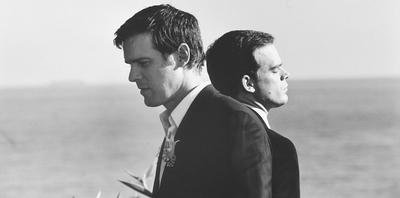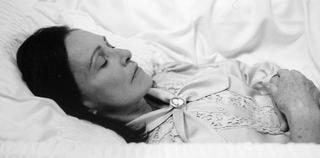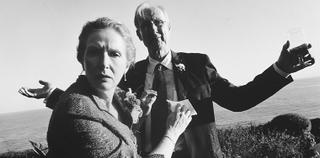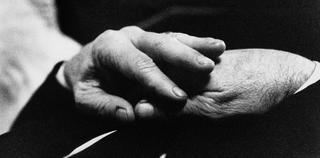
Saying Goodbye to the Fishers: A Memorial to Six Feet Under
Last night HBO aired the Six Feet Under series finale. For five seasons Six Feet Under, created by Alan Ball, and whose style and tone mirrored his subdued yet curiously energized Academy-award winning creation American Beauty, was engaging, infuriating, compelling, and, finally, undeniably satisfying.
The show followed the Fisher family and the friends, lovers, and relatives who inhabited the landscape of their strange lives in an anonymous section of Los Angeles, adding yet another mythic dimension to the city's reputation. The Fishers owned and operated a mortuary and funeral home above which several of the characters lived off-and-on during much of the show. Each episode began with a vignette of death—such as an unexpected and violent attack on a hiker by a mountain lion or self strangulation during a solo sex act—followed by a blank screen on which appeared the name of the deceased and his or her birth and death dates. The fact that death informed every episode didn't in itself make the show macabre or depressing.
 Instead, the Fisher's day-to-day interaction with the dead only reinforced the notion that life and death are so tightly intertwined as to elicit no more than a shrug and a ho-hum. (It should be noted here that the amazing and brilliant Frances Conroy as Ruth Fisher, with her slumped shoulders and glum demeanor, redefined the resignation and indifference inherent in a shrug.) Six Feet Under's greatest achievement was in demonstrating how precipitous is the crest of the hill we navigate between death and life. And how in a split second we reach out to grasp the hand of somebody we trust to steady us lest we fall. And even were we to fall from life, certain of the show's characters, Richard Jenkins's Nathaniel Fisher—the show's patriarch, who died calamitously in the series' first episode—and Peter Krause's Nate Fisher, revealed that the boundary between death and life is, as was evidenced by the one-on-one dialogues carried on between each of them and their living counterparts, wondrously permeable.
Instead, the Fisher's day-to-day interaction with the dead only reinforced the notion that life and death are so tightly intertwined as to elicit no more than a shrug and a ho-hum. (It should be noted here that the amazing and brilliant Frances Conroy as Ruth Fisher, with her slumped shoulders and glum demeanor, redefined the resignation and indifference inherent in a shrug.) Six Feet Under's greatest achievement was in demonstrating how precipitous is the crest of the hill we navigate between death and life. And how in a split second we reach out to grasp the hand of somebody we trust to steady us lest we fall. And even were we to fall from life, certain of the show's characters, Richard Jenkins's Nathaniel Fisher—the show's patriarch, who died calamitously in the series' first episode—and Peter Krause's Nate Fisher, revealed that the boundary between death and life is, as was evidenced by the one-on-one dialogues carried on between each of them and their living counterparts, wondrously permeable.The series’ first season was a revelation or sorts. For those of us who admired Ball's writing for the film American Beauty, it was a reunion with his nuanced approach to articulating a character’s personality. Those characters’ individual identities seemed fully formed, even in the early episodes. Nate was the prodigal son, bristling at the responsibility to family he felt compelled to embrace following his father's death. His brother David (Michael C. Hall), gay and closeted, was rigid and uptight. The contrast between David and Nate was startling, and it was hard not to be drawn to Nate's romantic and poetic nature. Brenda (Rachel Griffiths), Nate's on-again-off-again love interest throughout the series until they were married this season, was spontaneous and effervescent. The enamel smooth surface of serenity that Ruth, the Fisher matriarch, exuded was already beginning to show signs of fractures. One of the most rewarding experiences of each episode was witnessing Ruth's combustible eruptions. They were hilarious, frightening, unexpected, and unnerving all at once.
 Claire (Lauren Ambrose), the youngest Fisher, was adrift in an adolescent haze. She had only a passing acquaintance with her older brother Nate, who had left home to live in Seattle when she was still very young, and felt alienated from Ruth and David. As a teenager she was uncertain of her own identity. It seemed overwhelming, and the writers never let the viewer forget it, that she should try to read and understand her wounded and defensive family.
Claire (Lauren Ambrose), the youngest Fisher, was adrift in an adolescent haze. She had only a passing acquaintance with her older brother Nate, who had left home to live in Seattle when she was still very young, and felt alienated from Ruth and David. As a teenager she was uncertain of her own identity. It seemed overwhelming, and the writers never let the viewer forget it, that she should try to read and understand her wounded and defensive family.Keith (Mathew St. Patrick), David's African-American lover, was a gay hero for many viewers. Tall and broad shouldered, he was also an openly and proudly gay officer with the Los Angeles Police Department. He challenged David's internal homophobia and encouraged him to tell his family about his sexual identity. Federico (Freddy Rodriguez), an Hispanic staff person at the funeral home, struggled for his place in the business following Nathaniel's death. Rico’s talent for restoring the most devastatingly wrecked corpse ensured he would prevail. All of this day-to-day emotional and mental intrigue was presented and exquisitely rendered by an accomplished crew under Alan Ball's direction.
 By the second season, however, all bets were off. Suddenly the writers seemed to treat the characters as though they'd manifested schizophrenic tendencies. Emotionally, nobody even remotely resembled who he or she was in the previous season. It wasn't too long before I lost patience, and my regular viewing dwindled. It occurs to me now that the characters were displaying the annoying behaviors so familiar to me from my own life. Wasn't I too capricious, fickle, hypersensitive, difficult, intensely happy, and, at the same time, filled with unrelenting despair and irrational crippling fears? David, Nate, Ruth, Brenda, Keith, Federico, and, of course, as expected, Claire were each as human in their behavior and responses to highs and lows as the people writing the words that tumbled from the actors' mouths.
By the second season, however, all bets were off. Suddenly the writers seemed to treat the characters as though they'd manifested schizophrenic tendencies. Emotionally, nobody even remotely resembled who he or she was in the previous season. It wasn't too long before I lost patience, and my regular viewing dwindled. It occurs to me now that the characters were displaying the annoying behaviors so familiar to me from my own life. Wasn't I too capricious, fickle, hypersensitive, difficult, intensely happy, and, at the same time, filled with unrelenting despair and irrational crippling fears? David, Nate, Ruth, Brenda, Keith, Federico, and, of course, as expected, Claire were each as human in their behavior and responses to highs and lows as the people writing the words that tumbled from the actors' mouths. "I just want to celebrate another day of living..." In the series’ final moments on Sunday, Nate appears as a music video performer, dressed in a white suit and suspenders and with Gucci shades, intoning Rare Earth's R&B classic. He's an apparition, of course, nudging Claire from her sleep, out of the Fisher home, and to a new start, as a photographer, perhaps, in New York City. "Thank you for giving me life," Claire tells her mother moments before leaving the house where she grew up. "You gave me life," Ruth replies. Celebrating life in all its awkward, painful, and exhilarating magnificence is what this show was all about.
The rest of the character's stories, if you're even remotely familiar with the show's trajectory during the past season, are tied up neatly and, mostly, without surprise. By the show's end they have cobbled together lives for themselves that reflect a transcendent hope. As Claire leaves the nurturing ghost of Nate in the distance, we see her enter onto a Los Angeles freeway that will take her east across the wide swath of desert that is southern California.
As she navigates the arid landscape to the plaintive strains of Australian singer Sia's "Breathe Me," significant events in the future lives of the principal characters emerge from Claire's reverie, punctuated by the familiar buff screen featuring the names, birth, and death dates of the characters as they, one-by-one, leave life. The encapsulating storyline device is not a new one, but it is profoundly moving.
 Among other snapshots of the Fisher's lives, we see Nate's and Brenda's baby Willa—born only a few weeks after Nate's death—celebrate her first birthday, David's and Keith's wedding, the ghosts of Nathaniel and Nate ushering Ruth to her own death, Claire getting married to Ted (Chris Messina)—a well-meaning right-wing ultra-conservative lawyer with whom she became lovers this season, Keith's murder by armed robbers, David's death, then Brenda's, and, finally, at the age of 102, in 2085, Claire lying in bed immobile with ancient and opaque eyes remembering all of the lovely and complicated people who have preceded her in death. The camera pans the walls of her room and we look back across time at familiar faces in photographs. Claire's death, too, is near.
Among other snapshots of the Fisher's lives, we see Nate's and Brenda's baby Willa—born only a few weeks after Nate's death—celebrate her first birthday, David's and Keith's wedding, the ghosts of Nathaniel and Nate ushering Ruth to her own death, Claire getting married to Ted (Chris Messina)—a well-meaning right-wing ultra-conservative lawyer with whom she became lovers this season, Keith's murder by armed robbers, David's death, then Brenda's, and, finally, at the age of 102, in 2085, Claire lying in bed immobile with ancient and opaque eyes remembering all of the lovely and complicated people who have preceded her in death. The camera pans the walls of her room and we look back across time at familiar faces in photographs. Claire's death, too, is near. "Everything ends," the finale's promotions promised. On Six Feet Under everything ended exquisitely.


<< Home